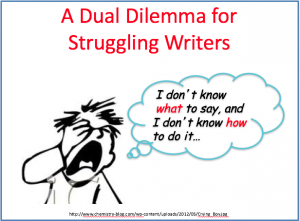At “Loose Ends”? Help is on the way for teachers of ELLs!
 Do you sometimes feel like you are being asked to do the impossible? Teach ’em academic English language, cover the content, get ready for high stakes tests – and do it all with limited time and resources. More Than English is my ongoing collection of resources and strategies that have worked the best for me. Teachers – ESL and mainstream – can use these tools to teach both language and content to all English Language Learners (ELLs) in grades K-12. ESL teachers need to be familiar with content area standards and mainstream teachers need to understand and support English Language Development (ELD). When we work together, we are all powerful! Go to my blog, Loosely Speaking, for updated strategies, resources, suggestions, and opinions. My most recent post is 10 Offers of Wisdom from Fictional Characters – Give the Gift of Reading.
Do you sometimes feel like you are being asked to do the impossible? Teach ’em academic English language, cover the content, get ready for high stakes tests – and do it all with limited time and resources. More Than English is my ongoing collection of resources and strategies that have worked the best for me. Teachers – ESL and mainstream – can use these tools to teach both language and content to all English Language Learners (ELLs) in grades K-12. ESL teachers need to be familiar with content area standards and mainstream teachers need to understand and support English Language Development (ELD). When we work together, we are all powerful! Go to my blog, Loosely Speaking, for updated strategies, resources, suggestions, and opinions. My most recent post is 10 Offers of Wisdom from Fictional Characters – Give the Gift of Reading.
Who are our students?
While over 100 languages are represented, the majority of ELLs in the United States come from Spanish speaking families. Most of our students were born in the US to parents whose first language is not English. We have also seen a recent influx of non-English speaking immigrants. Students and the teachers alike are struggling to survive. Newcomers need basic communication skills (BICs) , teachers need effective strategies, and all students need to gain academic language proficiency (CALPS) more quickly so they aren’t stuck in the LTELL (Long Term English Language Learner) quagmire.
Language Acquisition
To teach English learners effectively, it helps to know how a language is learned and/or acquired. This is a quick introduction for classroom teachers with no specific training in teaching English to speakers of other languages. For a more detailed presentation, read Language Acquisition: An Overview by Kristina Robertson and Karen Ford.
- Not all Languages are Alike (language comparisons)
- Factors that Affect Second Language Acquisition (chart)
- BICS and CALP – Language Distinctions from Jim Cummins (site)
- Stephen Krashen’s Monitor Model (video clip)
- Stages of Oral Language Acquisition (video clip)
- Zone of Proximal Development – Vygotsky
- Principles of Language Development from WIDA
So how do we accelerate language acquisition?
There are quite a few factors that affect Second Language Acquisition (SLA):
- Motivation / attitude
- First language literacy
- Similarities between L1 and L2
- Home support
- Life experience
- Personality and learning style
- Peer pressure / role models
- Cultural Background
- Quality of instruction
We only have control over the last factor – quality of instruction. Marzano and others have conducted research that indicates that the most important factor in a student’s success in school is the teacher. Whether or not our students are ELLs, we have to take into account all the factors – social, economic, and personal – that affect their ability to learn and succeed in school. But we can’t change them. As a colleague once told me, “The parents are sending us what they have. They aren’t keeping the best ones at home.”
The following resources and strategies for teaching ELLs are the ones I have found the most effective over the years. I hope they help you meet the challenge of accelerating language acquisition for your ELLS – short term, long term, and newcomers.
ELD Teaching Strategies by Content Area
- Questioning Strategies
- Active Listening Strategies
- Vocabulary and Academic Language
- Reading Strategies
- Visual Literacy – Diagrams
- Writing Strategies
- Math Strategies
- Science Strategies
- Social Studies Strategies (for Science, too)
Instructional Models
- Co-Teaching and Collaborative Teaching
- SIOP
- Small Group
- Strategies for all Instructional Models by Content Area
Resources by Content Area
- General Resources by Grade Level PreK – 12

- English Language Arts
- Math
- Newcomers
- Reading and Literacy
- Science
- Social Studies
- Writing
Standards – ELD, Common Core, Bloom’s
ELD standards Standards developed by WIDA for English Language Development in Listening, Speaking, Reading and Writing
- Performance Definitions
- Features of Academic Language
- Can-Do Descriptors
- Model Performance Indicators (MPI)
- ELD Standards
- WIDA Tutorial (video)
- Hampton Brown’s “Avenues” Correlations K-5
Common Core Standards Common Core Standards for ELA and Math with resources specifically designed to teach these standards. These standards are demanding but they can be taught to students at all levels of English language proficiency with the appropriate corresponding strategies.
- Background Information
- ELA
- Math The emphasis is on multiple ways of solving a problem, not just memorizing algorithms. Ask Ma and Pa Kettle.
- Making Vocabulary Number One Vocabulary building is the number one challenge across content areas and grade levels.
Essential Standards Standards developed by North Carolina for the other content areas
- Arts Education
- English as a Second Language
- Guidance
- Healthful Living – Physical Education
- Information and Technology
- Occupational Course of Study (OCS)
- Science
- Social Studies
- World Languages
Bloom’s Revised Taxonomy In this rapidly changing world we must work to develop higher level thinking skills in our students, regardless of language proficiency. Andy Griffith knew this.
So did Harry Potter.
- What is Bloom’s Taxonomy?
- So how do I use this in the classroom?
- From the student’s point of view: Engage me!
- From a teacher’s point of view: Flip This!
- Useful resources
- What is Webb’s Depth of Knowledge (DOK)?
Lesson Planning – How To
Tools, templates, and vocabulary lists to help you combine content and language objectives in your classes. The World Depends on Them!
The Law
An historical overview of major court decisions and legislation, and how they guide instruction, plus information on immigration reform
- 2015 Guidelines from the U.S. Departments of Education and Justice
- Historical Overview
- How the Law Guides School Procedures
- Immigration
EC or ESL
Research based suggestions on how to determine if a struggling ELL also has a learning disability
Tech Tools for All Teachers
Handy tools for everyone, not just ESL teachers
ESL Sites
A handful of my favorite sites
Loosely Speaking
My take on current issues, challenges, and strategies for teaching content and language to ELLs
Spanish Resources
Padres de Familia: Information in Spanish for parents to empower greater involvement in their child’s education
- Información General
- Sitios de Internet para Aprender Inglés
- Sitios de Internet para Practicar Lectura en Inglés y Español
- Cómo ayudar a su hijo/a aprender leer
- Guías Para Padres Para Fomentar El Éxito Escolar
Bilingual Letters and Forms
- Tips for Involving Families of ELLs
- Administrative – Registration and Enrollment
- Administrative – General Communication
- Teacher – Notes Home
- Specific Academic Programs and Services
- Health Related
I continue to add new finds to this site so if you would like to be updated automatically, enter your email at the upper right and “subscribe.” I welcome suggestions for other resources to be included in this site. Please use my contact form or email me directly at jessicaloose.obx@gmail.com.
Jessica Loose – MsED TESOL, Reading Specialist, Curriculum Specialist
photo credit: Eve Turek, Yellowhouse Gallery, Nags Head, NC



4 Comments
Leave a reply →